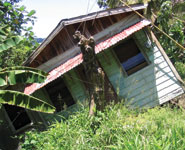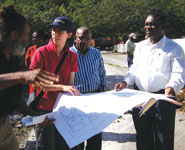Globally, more and more people are moving to urban areas where shanty developments are unregulated and unplanned. Typically, in the eastern Caribbean, more than 60% of the housing is of this nature. As a consequence, the susceptibility of slopes to landslides is increased by development activities that change slope geometry, strength, loading, vegetation cover, surface-water and groundwater regimes. So the risk of landslides is increasing simply because the population is increasing and the problem is growing at a faster rate than it is being solved.
Once Anderson and Holcombe identify an area that is particularly at risk, the first thing they do is to involve the local community. They hold meetings with residents who help them draw up detailed maps identifying past landslides, drainage issues and localised indicators of instability. Somewhat surprisingly, even in these unplanned developments, water companies often supply water to individual properties, but provide no drainage to take waste water away. So the skill is in managing the flow of water on the hill slopes to ensure that as little as possible goes into the soil, thereby improving the stability of the slope. Using the landslide risk prediction software they have developed, they can model an individual scenario – the density of housing on the slope, the angle of the slope, the type of soil and the amount of water moving through it. The software then predicts whether removing water from the soil will make the development safer or not. It is important not to raise people’s expectations unrealistically, as occasionally they find areas that cannot be improved.
Globally, more and more people are moving to urban areas where shanty developments are unregulated and unplanned
Once the problems have been identified, the work is tendered into the community, the idea being that individuals develop some business acumen which they can then use elsewhere. The team also runs training courses in using the software and in the skills needed for putting in drainage and stabilising the slopes. These participants then become ambassadors for the scheme. As one of them recently told Anderson: “The thing you must understand here is that if you’re lucky you might get just one chance in your lifetime of moving out and doing something with your life. I’ve learned how to build drains and why to do stuff and that’s given me a chance.”
“But,” says Anderson, “it’s not always straightforward. Not only do you have to get the science right, you have to get the engagement with the people right as well. When people have been umemployed for several years they’re very keen to get paid and tend to rush the job, so it’s vital to explain that the work must be done slowly and properly, rather than risk having the whole thing fall down again.” Utilising the local community in this way not only gives individuals new skills, but also means that about 80% of the funding Anderson obtains is actually spent in the community, in the form of labour costs and construction materials for the drainage infrastructure. This is recognised in the region and beyond to be truly cost-effective.
A further unintended benefit that has recently come to light is that putting drainage into an area also removes stagnant water; consequently, the incidence of dengue fever and other diseases that flourish in such conditions declines and people’s health starts improving.
About 80 per cent of the funding Anderson obtains is spent in the community
The approach has fundamentally changed communities’ perspectives: the landslide risks they face can be reduced and people can sleep again at night – a problem many have during periods of heavy rain. It is clear that ‘end-to-end’ community engagement encourages participation in the planning, execution and maintenance of the landslide risk reduction measures. The result is that the intervention is ‘owned’ by the community.
Having proved the concept, the next step is to provide remote access to Anderson and Holcombe’s landslide risk prediction software. To this end, physicists at Bristol have suggested a collaboration, using their expertise on software development already applied to the Large Hadron Collider project. This technology transfer would build sophisticated grid-computing capacity for MoSSaiC and tailor internet access to the software and data management system for all levels of aptitude, from complete beginners to technical engineers. The prototype was successfully trialled in the Caribbean earlier this year, returning landslide predictions within minutes. The team has now applied for funding to develop it fully.
Last year, as affirmation of their success in this arena, Anderson and Holcombe were asked by the World Bank to join its team in Washington that looks at disaster risk reduction. But this won’t mean that they will now spend all their time formulating policies that take years to be implemented. On the contrary, they are both determined to continue making a real difference on the ground by applying the combined outcomes of their technical and policy research.


